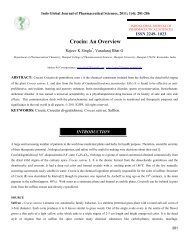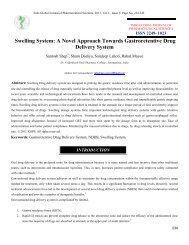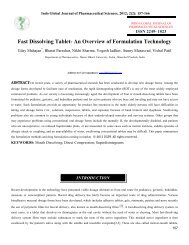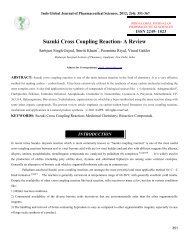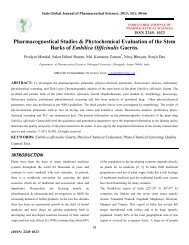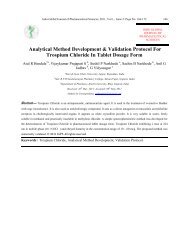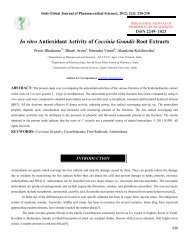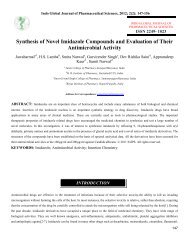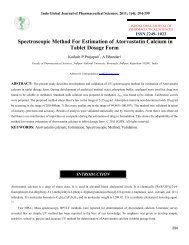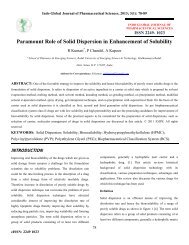A Review: Development & Validation of HPLC Method - Indo Global ...
A Review: Development & Validation of HPLC Method - Indo Global ...
A Review: Development & Validation of HPLC Method - Indo Global ...
Create successful ePaper yourself
Turn your PDF publications into a flip-book with our unique Google optimized e-Paper software.
<strong>Indo</strong> <strong>Global</strong> Journal <strong>of</strong> Pharmaceutical Sciences, 2012; 2(2): 191-196[3]. Esomeprazole is cost effective in treatment <strong>of</strong> gastric oesophageal reflux diseases [4]. Esomeprazole magnesium was developed asthe S-isomer <strong>of</strong> omeprazole as an attempt to improve its pharmacokinetic properties [5]. It is the first PPI available for clinical use as asingle isomer. It demonstrates pharmacological and clinical benefits beyond those seen with the racemic omeprazole [6]. This opticalisomer is subject to less first-pass metabolism and lower plasma clearance than omeprazole, thereby <strong>of</strong>fering higher systemicbioavailability [7]. Esomeprazole has higher and more consistent bioavailability than omeprazole [6]. Esomeprazole reduces acidsecretion through inhibition <strong>of</strong> K + /H + ATPase in gastric parietal cells. By inhibiting the functioning <strong>of</strong> this enzyme, the drug preventsformation <strong>of</strong> gastric acid. Gastroesophageal Reflux Disease (GERD) is a Condition in which the digestive acid in the stomach comesin contact with the oesophagus (food pipe). The irritation caused by this disorder is known as heartburn. Long term contact betweenthe acid and oesophagus can cause permanent damage to the Oesophagus. Esomeprazole (Nexium) reduces the production <strong>of</strong>digestives acids, thus minimizing their effect on the oesophagus [8]. Esomeprazole is highly bound (97%) to plasma proteins andprimarily metabolized by 2 cytochrome P 450 (CYP) isozymes, CYP3A4 and CYP2C19, with CYP2C19 being the predominantmetabolic pathway [9]. There are stereoselective differences in the metabolism <strong>of</strong> PPIs by the cytochrome P450 (CYP) isoenzymes2C19 and 3A4, and this is the basis <strong>of</strong> the observed pharmacodynamic and clinical efficacy differences between esomeprazole andomeprazole [8-11]. A study in which these enzymes were expressed from cDNAs suggested that CYP2C19 is responsible for 40% and87% <strong>of</strong> the total intrinsic clearance <strong>of</strong> S- and R-omeprazole, respectively, indicating esomeprazole would be cleared more slowly invivo [7]. Esomeprazole magnesium induced an increase in total antioxidant capacity and Cu/Zn–superoxide dismutase activity instomach [14].H 3 CONNHSOCH 3OCH 3NCH 3Structure <strong>of</strong> EsomeprazoleProton Pump Inhibitor: Proton pump inhibitors (PPIs) are very effective for the treatment <strong>of</strong> symptoms and the healing <strong>of</strong> erosive andulcerative disease in the spectrum <strong>of</strong> acid-related disorders (duodenal and gastric ulcer disease and erosive esophagitis). PPIs producesignificantly more effective and prolonged acid suppression than H2-receptor antagonists (H2-RAs) and maintain a pH >4 for up to18–20 h/day. It has been demonstrated that healing in acid-related disorders is directly related to the degree and duration <strong>of</strong> acidsuppression and the length <strong>of</strong> treatment [15-19].Pharmacology: It is a prototype member <strong>of</strong> substituted benzimidazoles. The significant pharmacological action <strong>of</strong> esomeprazole isdose dependent suppression <strong>of</strong> gastric acid secretion; without anticholinergic or H2 blocking action. It is a powerful inhibitor <strong>of</strong>gastric acid: can totally abolish HCl secretion, both resting as well as stimulated by any <strong>of</strong> the secretagogues, without much effect onpepsin, intrinsic factor, juice volume and gastric motility. The omeprazole is inactive in neutral pH, but at pH below 5 rearranges to192
<strong>Indo</strong> <strong>Global</strong> Journal <strong>of</strong> Pharmaceutical Sciences, 2012; 2(2): 191-196two charged cationic forms (a sulphenic acid and sulphenamide configurations) that react covalently with SH groups <strong>of</strong> theH + K + ATPase enzyme and inactivate it irreversibly, specially two molecules <strong>of</strong> omeprazole were react with one molecule <strong>of</strong> enzyme.But unlike omeprazole, esomeprazole claimed to produce better control <strong>of</strong> intragastric pH than omeprazole in GERD patients [5].VARIOUS METHODSArmagan Onal et al (2006) developed and validated a method for routine quality control analysis <strong>of</strong> esomeprazole magnesiumtrihydrate in tablets. Separation was achieved isocratically on C 18 column utilizing a mobile phase <strong>of</strong> ACN/phosphate buffer (60:40,v/v, pH 7) at flow rate <strong>of</strong> 1.0 ml/min. with UV detection at 205 nm using lansoprazole as an internal standard. The calibration curve <strong>of</strong>esomeprazole was linear in the range <strong>of</strong> 100~1000 µg/ml (r = 0.9992, n = 4). The mean recovery for esomeprazole from tablets rangedbetween 97.82~98.22% [20].Patel B. H. et al (2007) described a simple, sensitive, and precise high performance liquid chromatographic method for theanalysis <strong>of</strong> pantoprazole, rabeprazole, esomeprazole, domperidone and itopride, with ultraviolet detection at 210 nm, has beendeveloped, validated, and used for the determination <strong>of</strong> compounds in commercial pharmaceutical products. The compounds werewell separated on a Hypersil BDS C18 reversed-phase column by use <strong>of</strong> a mobile phase consisting <strong>of</strong> 0.05 M, 4.70 pH, potassiumdihydrogen phosphate buffer - acetonitrile (720:280 v/v) at a flow rate <strong>of</strong> 1.0 mL min −1 . The linearity ranges were 400–4,000 ngmL −1 for pantoprazole, 200–2,000 ng mL −1 for rabeprazole, 400–4,000 ng mL −1 for esomeprazole, 300–3,000 ng mL −1 fordomperidone and 500–5,000 ng mL −1 for itopride. Limits <strong>of</strong> detection (LOD) obtained were: pantoprazole 147.51 ng mL −1 ,rabeprazole 65.65 ng mL −1 , esomeprazole 131.27 ng mL −1 , domperidone 98.33 ng mL −1 and itopride 162.35 ng mL −1 . The studyshowed that reversed-phase liquid chromatography is sensitive and selective for the determination <strong>of</strong> pantoprazole, rabeprazole,esomeprazole, domperidone and itopride using single mobile phase [21].Hultman I. et al (2007) described a LC-MS/MS method was developed for quantitative determination <strong>of</strong> esomeprazole, andits two main metabolites 5-hydroxyesomeprazole and omeprazole sulphone in 25 _L human, rat or dog plasma. The analytes and theirinternal standards were extracted from plasma into methyl tert-butyl ether - dichloromethane (3:2, v/v). After evaporation andreconstitution <strong>of</strong> the organic extract the analytes were separated on a reversed phase LC column and measured by atmosphericpressurepositive ionisation MS. The linearity range was 20–20,000 nmol/L for esomeprazole and omeprazole sulphone, and 20–4000nmol/L for 5-hydroxyesomeprazole. The extraction recoveries ranged between 80 and 105%. The intra- and inter-day imprecisionwere less than 9.5% with accuracy between 97.7% and 100.1% for all analytes [22].Kumar Putta Rajesh et al (2010) developed and validated a UV spectrophotometric method for esomeprazole magnesiumtrihydrate and its physico-chemical characterization. Physico chemical characterization studies showed that EMT has showed amelting point <strong>of</strong> 177.330 C. The solubility <strong>of</strong> drug esomeprazole followed the order methanol>ethanol> acetone> buffer pH 9.0 >distilled water. The analytical method developed for the estimation <strong>of</strong> esomeprazole magnesium trihydrate in bulk fluids showedmaximum absorbance λmax <strong>of</strong> 203.5 nm in methanol between 200 nm and 400 nm. Linearity studies indicated that estimation <strong>of</strong>esomeprazole magnesium trihydrate between 2.00 μg /ml to 10.00 μg /ml was found to be linear with regression equation <strong>of</strong> y =0.1546*X - 0.00414; ( r2 = 0.999). Limit <strong>of</strong> Quantitation <strong>of</strong> esomeprazole was found to be <strong>of</strong>1.00 μg/ml. The above analyticalparameters indicated that the developed UV Spectrophotometric method <strong>of</strong> esomeprazole was simple, accurate and reproducible [2].193
<strong>Indo</strong> <strong>Global</strong> Journal <strong>of</strong> Pharmaceutical Sciences, 2012; 2(2): 191-196Zanitti L. et al (2010) described an analytical and semi preparative high-performance liquid chromatography (<strong>HPLC</strong>)enantioseparation <strong>of</strong> the proton-pump inhibitor omeprazole (OME) and its potential organic chiral impurities were accomplished onthe immobilised-type Chiralpak IA chiral stationary phase (CSP) under both polar organic and normal-phase conditions. The (S)-enantiomers were isolated with a purity <strong>of</strong> >99% ee and their absolute configuration were empirically assigned by circular dichroism(CD) spectroscopy. A chemo- and enantioselective <strong>HPLC</strong> method was validated to control the enantiomeric purity <strong>of</strong> the (S)-enantiomer <strong>of</strong> OME (ESO), an active ingredient contained in drug products, in the presence <strong>of</strong> chiral and achiral related substances.The precision, linearity and accuracy <strong>of</strong> the determination <strong>of</strong> the (R)-impurity as well as the recovery <strong>of</strong> ESO from a pharmaceuticalpreparation were determined. The proposed method uses the mixture methyl tert-butylether (MtBE)–ethyl acetate (EA)–ethanol(EtOH)–diethylamine (DEA) 60:40:5:0.1 (v/v/v/v) as a mobile phase. In these conditions, linearity over the concentration range 0.5–25_g/ml for (R)-enantiomer was obtained. The limits <strong>of</strong> detection and quantification were 99 and 333 ng/ml, respectively. The intraand inter-day assay precision was less than 2% (RSD %) [1].Nalwade Santaji Uttam et al (2011) developed a RP-UPLC method for quantitative determination <strong>of</strong> esomeprazolemagnesium and its seven impurities in pharmaceutical dosage forms. Separation has been achieved on an acquity BEH C 18 , 50 mm ×2.1 mm, 1.7 µm with buffered mobile phase consisting solvent A (0.04 M glycine ( pH 9.0) buffer) and solvent B ( mixture <strong>of</strong> ACNand milli Q water in the ratio 90:10 ( v/v) ; resp.) delivered at flow rate <strong>of</strong> 0.2 ml/min and detection wavelength 305 nm. The drug wassubjected to stress conditions. The stress samples were assayed against a reference standard and the mass balance was found to beclose to 99.1 % [23].Kumar T. Santhosh et al. (2011) developed and validated a new simple, accurate, rapid and precise isocratic <strong>HPLC</strong> methodfor determination <strong>of</strong> esomeprazole and domperidone in capsule formulation, The method employs waters <strong>HPLC</strong> system on ThermoRP 8 column (4.6 ×150mm and 3.5 µm) and flow rate <strong>of</strong> 1 ml/min. with a load <strong>of</strong> 20 µl. ACN and phosphate buffer was used as mobilephase in the composition <strong>of</strong> 35:65 at 289 nm. Percent recovery values <strong>of</strong> esomeprazole and domperidone were found to be within 98-102 % as per ICH guidelines [12].Jain Deepak kumar et al. (2011) described the simple, precise, sensitive RP-<strong>HPLC</strong> method which has been validated todetermine esomeprazole magnesium trihydrate and naproxen in synthetic mixture form. Chromatographic separation was achievedisocratically on phenomenex luna C 18 column (5µm, 150 mm × 4.5 mm) and ACN: phosphate buffer (pH 7.0) in the ratio 50: 50 (v/v)as the mobile phase, at a flow rate <strong>of</strong> 0.5 ml/min. Detection was carried out at 300 nm. The method was linear in the concentrationrange <strong>of</strong> 50-250 µg/ml for naproxen and 2-10 µg/ml for esomeprazole with correlation coefficient <strong>of</strong> 0.9999 and 0.9998 resp. Themean recoveries obtained for naproxen and esomeprazole were 100.01 % and 97.76 % resp. and RSD was less than 2 [24].Sharma S. et al (2011) developed and validated a method for estimation <strong>of</strong> esomeprazole and domperidone as bulk andpharmaceutical form. The chromatographic development was carried out on precoated silica gel 60 F 254 aluminium plates usingmixture <strong>of</strong> ethyl acetate;1,4 dioxane: methanol:25 % ammonia in the ratio <strong>of</strong> 15:1.5:3:1.5 v/v. The drug was satisfactorily resolvedwith R f valve 0.36±0.12 and 0.53±0.52 esomeprazole and domperidone respectively. The accuracy and repeatability <strong>of</strong> the proposedmethod was ascertained by evaluating various validation parameters like linearity (200 to 700) ng/spot and 300 to 900 ng/spotesomeprazole and domperidone resp., precision (intra-day RSD 0.143, 0.237 and %), inter-day RSD 0.351 and 0.549 esomeprazoleand domperidone resp., accuracy (99.93±0.52) and specificity according to ICH guidelines. The linearity was obtained withcorrelation coefficients (r 2 = 0.9992) and (r 2 = 0.9997) for esomeprazole and domperidone respectively. The method was validated asper ICH guidelines [4].194
<strong>Indo</strong> <strong>Global</strong> Journal <strong>of</strong> Pharmaceutical Sciences, 2012; 2(2): 191-196REFERENCES1. Zanitti, L.; Ferretti, R.; Gallinella B.; Torre F.L.; Sanna M.L.; Mosca A.; Cirilli R. * Direct <strong>HPLC</strong> enantioseparation <strong>of</strong> omeprazoleand its chiral impurities: Application to the determination <strong>of</strong> enantiomeric purity <strong>of</strong> esomeprazole magnesium trihydrate, J. Pharm.Biomed. Anal. 52(2010), pp 665-671.2. Putta, R.K.; Somasshekar, S.; Mallikarjuna, G.M.; Kumar, S.M.S.; Physico-chemical characterization, uv spectrophotometricmethod development and validation studies <strong>of</strong> esomeprazole magnesium trihydrate, J. Chem. Pharm. Res., 2010, 2(3):484-490.3. Gisbert, J.P, Pajares, J.M. Esomeprazole-based therapy in Helicobacter pylori eradication: a meta-analysis Digestive and LiverDisease 36 (2004) 253–2594. Sharma s.; Sharma M.C. Densitometric method for quantitative determination <strong>of</strong> esomeprazole and domperidone in dosage form,Am.-Eurasian J. Toxicological Sci. 3(3): 143-148, 2011.5. Kulkarni S., Tripathi S., Mehta P D., Lodhi N.S., Sengar N.P.S. Esomeprazole In The Treatment Of Acidic Disorder : AnOvereview, Asian Journal <strong>of</strong> Biochemical and Pharmaceutical Research Issue 2 (Vol. 1) 2011 5626. Lindberg P., Andersson T., Lundborg P., Carlsson E. <strong>Review</strong> article: esomeprazole — enhanced bio-availability, specificity for theproton pump and inhibition <strong>of</strong> acid secretion. Aliment Pharmacol Ther 2003; 17: 481–488.7. Liang X.Y, Gao Q., Gong N.P,Tang L.P.,Wang, Tao X., Comparison <strong>of</strong> esomeprazole enteric-coated capsules vs esomeprazolemagnesium in the treatment <strong>of</strong> active duodenalulcer: A randomized, double-blind, controlled study World J Gastroenterol 2008March 28; 14(12): 1941-19458. Andersson T, Hassan-Alin M, Hasselgren G, Rohss K, WeidolfL. Pharmacokinetic studies with esomeprazole, the (S)-isomer<strong>of</strong>omeprazole. Clin Pharmacokinet 2001; 40: 411-4269. Isaza C, Henao J, Martinez JH, Arias JC, Beltran L. Phenotypegenotype analysis <strong>of</strong> CYP2C19 in Colombian mestizo individuals.BMC Clin Pharmacol 2007; 7: 610. Blume H, Donath F, Warnke A, Schug BS. Pharmacokinetic drug interaction pr<strong>of</strong>iles <strong>of</strong> proton pump inhibitors. Drug Saf 2006; 29:769-78411. Furuta T, Sugimoto M, Shirai N, Ishizaki T. CYP2C19 pharmacogenomics associated with therapy <strong>of</strong> Helicobacter pylori infectionand gastro-esophageal reflux diseases with a proton pump inhibitor. Pharmacogenomics 2007; 8: 1199-121012. Kumar S.T., Kumar B.K, Kumar A. S, Mohan M., NandaS.S., VenkateshwarRao P. <strong>Development</strong> and <strong>Validation</strong> <strong>of</strong> RP-<strong>HPLC</strong><strong>Method</strong> for Simultaneous Estimation <strong>of</strong> Esomeprazole and Domperidone in Pharmaceutical Dosage Form Journal <strong>of</strong> PharmacyResearch 2011,4(11),4097-409913. Ullah, A.Md.; Dowla, S.U.; Maruf, A.A.; Azad, A.K.Md.; Sultana, R.; Shohag, H.Md. Relative bioavailability and pharmacokineticproperties <strong>of</strong> two different enteric formulations <strong>of</strong> esomeprazole in healthy bangladeshi volunteers: an open-label, single-dose,randomized-sequence, Clinical Therapeutics, 2010 (32).14. Timothy R. Kocha, Ann Petrob, Marcus Darrabieb, Emmanuel C. Oparab Effect <strong>of</strong> the H, K–ATPase inhibitor, esomeprazolemagnesium, on gut total antioxidant capacity in mice, Journal <strong>of</strong> Nutritional Biochemistry 15 (2004) 522–52615. Richard H. Hunt, David Armstrong, Cindy James, R.N., Sadat K. Chowdhury, Yuhong Yuan, Paola Fiorentini, Alain Taccoen, andPatrick Cohen, Effect on Intragastric pH <strong>of</strong> a PPI with a Prolonged Plasma Half-Life: Comparison between Tenatoprazole andEsomeprazole on the Duration <strong>of</strong> Acid Suppression in Healthy Male Volunteers, Am J Gastroenterol 2005;100:1949–195616. Jones, D.B, Howden C.W, Burget, D.W, et al. Acid suppression in duodenal ulcer: A meta-analysis to define optimal dosing withantisecretory drugs. Gut 1987; 28: 1120–27.17. Howden, C.W, Jones D.B, Peace KE, et al. The treatment <strong>of</strong> gastric ulcer with antisecretory drugs. Relationship <strong>of</strong> pharmacologicaleffect to healing rates. Dig Dis Sci 1988; 33: 619–24.18. Burget D.W, Chiverton S.G, Hunt R.H. Is there an optimal degree <strong>of</strong> acid suppression for healing <strong>of</strong> duodenal ulcers? A model <strong>of</strong>the relationship between ulcer healing and acid suppression. Gastroenterology 1990; 99:345–51.19. Bell N.J, Hunt R.H. Role <strong>of</strong> gastric acid suppression in the treatment <strong>of</strong> gastro-oesophageal reflux disease. Gut 1992; 33:118–24.20. Onal A.; Oztunç A. <strong>Development</strong> and validation <strong>of</strong> high performance liquid chromatographic method for the determination <strong>of</strong>esomeprazole in tablets, J. Food Drug Anal., Vol. 14, No. 1, 2006, pp 12-18.21. Patel, B.H.; Suhagia, B.N.; Patel, M.M.; Patel, J.R. Determination <strong>of</strong> pantoprazole, domperidone, rabeprazole, esomeprazole anditopride in pharmaceutical products by reverse phase liquid chromatography using single mobile phase, Chromatographia,65(2007)11-12, pp-743-748.22. Hultman, I.; Stenh<strong>of</strong>f, H.; Liljeblad M. * Determination <strong>of</strong> esomeprazole and its two metabolities in human, rat and dog plasma byliquid chromatography with tandem mass spectrometry, J Chromatography B, 848(2007), pp 317-322.195
<strong>Indo</strong> <strong>Global</strong> Journal <strong>of</strong> Pharmaceutical Sciences, 2012; 2(2): 191-19623. Nalwade, S.U. * ; Reddy V.R.; Rao D.D.; Morisetti N.K. A validated stability indicating ultra performance liquid chromatographicmethod for determination <strong>of</strong> impurities in esomeprazole magnesium gastro resistant tablets, J. Pharm. and Biomed. 57(2012), pp109-114.24. Jain D.R.; Jain N.; Charde R.; Jain N. The RP-<strong>HPLC</strong> method for simultaneous estimation <strong>of</strong> esomeprazole and naproxen in binarycombination, Pharm. <strong>Method</strong>s, 2011.<strong>Indo</strong> <strong>Global</strong> Journal <strong>of</strong> Pharmaceutical Sciences( ISSN 2249 1023 ; CODEN-IGJPAI) indexed and abstracted in EMBASE(Elsevier), SCIRUS(Elsevier),Chemical Abstract Services(CAS), American Chemical Society(ACS), IndexCopenicus, EBSCO, DOAJ, Google Scholar and many more. For further details,visit http://iglobaljournal.com196





